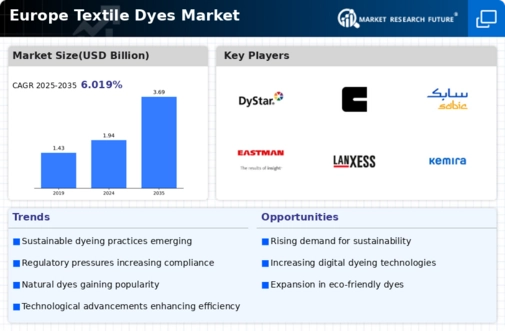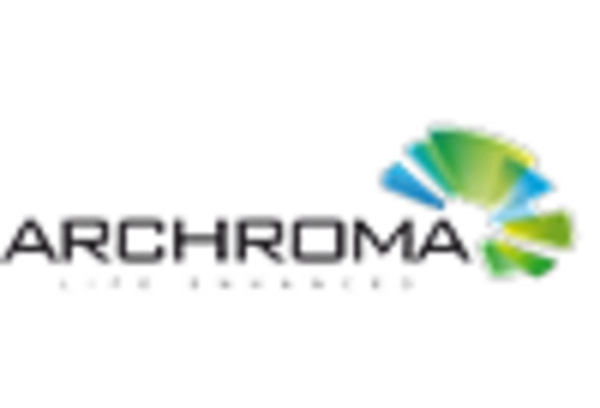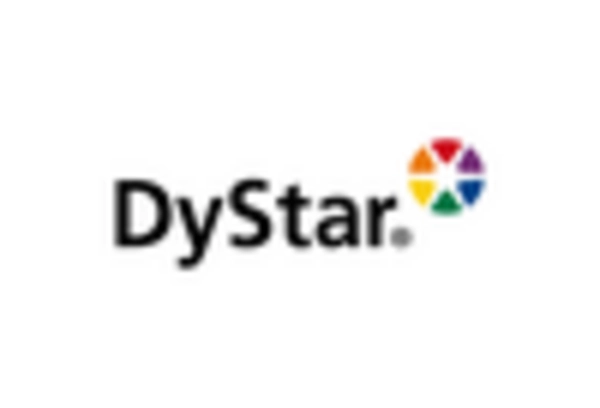Growth of the Fashion Industry
The textile dyes market in Europe is significantly influenced by the growth of the fashion industry, which is projected to expand at a CAGR of 5% over the next five years. This growth is attributed to the increasing consumer spending on apparel and the rising popularity of fast fashion. As fashion brands seek to differentiate their products, the demand for vibrant and diverse color palettes in textiles is escalating. Consequently, the textile dyes market is likely to see a surge in the use of synthetic dyes, which offer a broader range of colors and better colorfastness. This trend not only enhances the aesthetic appeal of garments but also drives innovation in dyeing techniques, thereby contributing to the overall growth of the market.
Rising Demand for Eco-Friendly Dyes
The textile dyes market in Europe is experiencing a notable shift towards eco-friendly dyes, driven by increasing consumer awareness regarding environmental sustainability. As consumers become more conscious of the ecological impact of their purchases, the demand for dyes that are biodegradable and free from harmful chemicals is rising. This trend is reflected in the market, where eco-friendly dyes are projected to account for approximately 30% of the total market share by 2026. Manufacturers are responding by investing in research and development to create innovative dye solutions that meet these consumer preferences. The textile dyes market is thus adapting to these changing demands, which may lead to a more sustainable production process and a reduction in environmental pollution.
Expansion of E-commerce in Textile Sales
The expansion of e-commerce platforms is significantly impacting the textile dyes market in Europe. As online shopping becomes increasingly popular, textile manufacturers are adapting their strategies to cater to a broader audience. This shift is leading to a rise in demand for customized and unique textile products, which in turn drives the need for diverse dye options. The textile dyes market is likely to see an increase in the production of small batches of dyed textiles to meet the specific preferences of online consumers. This trend not only enhances consumer engagement but also encourages innovation in dyeing techniques, as manufacturers strive to offer unique color combinations and patterns that appeal to the online market.
Regulatory Pressures for Chemical Safety
The textile dyes market in Europe is increasingly influenced by regulatory pressures aimed at ensuring chemical safety in textile production. Stricter regulations regarding the use of hazardous substances in dyes are being implemented, compelling manufacturers to comply with safety standards. This regulatory environment is pushing the textile dyes market to innovate and develop safer alternatives to traditional dyes. As a result, there is a growing emphasis on the development of non-toxic and low-impact dyes, which are expected to capture a larger market share in the coming years. Compliance with these regulations not only enhances consumer trust but also positions companies favorably in a market that is progressively prioritizing safety and sustainability.
Technological Innovations in Dyeing Processes
Technological innovations are playing a crucial role in shaping the textile dyes market in Europe. Advanced dyeing technologies, such as digital printing and waterless dyeing methods, are gaining traction due to their efficiency and reduced environmental impact. These innovations allow for precise color application and minimize water usage, which is particularly important in regions facing water scarcity. The textile dyes market is likely to benefit from these advancements, as they enable manufacturers to produce high-quality textiles with lower operational costs. Furthermore, the integration of automation and artificial intelligence in dyeing processes may enhance production efficiency, potentially leading to a more competitive market landscape.

















Leave a Comment